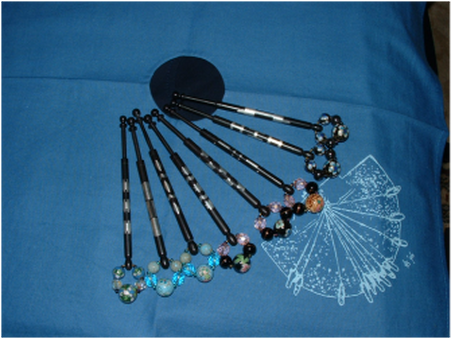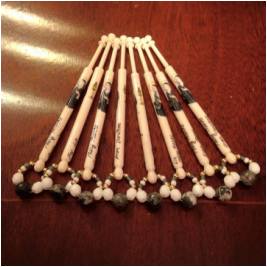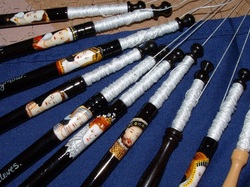Chris Parsons
 Pewter Inlaid - Originally 39 in the set but Chris has carried on making them
Pewter Inlaid - Originally 39 in the set but Chris has carried on making them
Chris Parsons (website http://www.lace-bobbins.co.uk/) makes some very beautiful to look at bobbins which I find are also very easy to handle.
Recently I've been working pieces that either need sewings or a lot of bobbins. Having a bobbin maker who you can rely on to produce smooth bobbins that easily go through the threads for sewing is important. Also having bobbins which intrinsically have a good weight to them so that you don't need large spangles for weight is another consideration.
When I first started making lace I loved the look and feel of the bone bobbins but was appalled at the price they commanded.
If I was to try to compare the price of a bone bobbin back in 1991, when I started to make lace, then I use a simple measure to compare costs. I work in either pints of beer or how many hours I would need to work in my job to afford one. OK, so I earn more money these days, but beer has gone up by a standard inflation way.
The first pair of bone bobbins I bought cost 24 pints of beer or would have taken me 8 hours of my time to purchase a single pair of bobbins. Chris's pewter inlaid bobbins are equivilant in cost to bone - these days a pair would cost around 8 pints of beer or just two hours of my time. They have come done considerably.
I bought bone because they looked wonderful but it wasn't until about 10 years later when I started to make patterns with many bobbins on them that I understood how bone was basically heavier but thinner so you could get more bobbins on the pillow.
My current project has over 70 pairs on it at any one time - over 140 bobbins. The sheer weight of this when I work on my lap (I know I shouldn't) would be terrible if you take into account the bobbins and beads. I like a certain weight of bobbin / bead to thread to keep the thread taught. But really, it's the way that they bobbin handles when you use it that is very essential to me. The right weight and I will make last far faster.
My curren piece has maderia varigated thread on it (as weavers) which is a little slippery on the bobbin and requires a double half hitch off the shank and on the head to keep it in place (even so, when not in use it just simply slides off the head and comes undone). The bobbins with the maderia thread on seem to need just a little more weight to deal with the slippery thread so I went for the pewter inlaid from Chris and made sure they had good heavy glass beads on them.
Recently I've been working pieces that either need sewings or a lot of bobbins. Having a bobbin maker who you can rely on to produce smooth bobbins that easily go through the threads for sewing is important. Also having bobbins which intrinsically have a good weight to them so that you don't need large spangles for weight is another consideration.
When I first started making lace I loved the look and feel of the bone bobbins but was appalled at the price they commanded.
If I was to try to compare the price of a bone bobbin back in 1991, when I started to make lace, then I use a simple measure to compare costs. I work in either pints of beer or how many hours I would need to work in my job to afford one. OK, so I earn more money these days, but beer has gone up by a standard inflation way.
The first pair of bone bobbins I bought cost 24 pints of beer or would have taken me 8 hours of my time to purchase a single pair of bobbins. Chris's pewter inlaid bobbins are equivilant in cost to bone - these days a pair would cost around 8 pints of beer or just two hours of my time. They have come done considerably.
I bought bone because they looked wonderful but it wasn't until about 10 years later when I started to make patterns with many bobbins on them that I understood how bone was basically heavier but thinner so you could get more bobbins on the pillow.
My current project has over 70 pairs on it at any one time - over 140 bobbins. The sheer weight of this when I work on my lap (I know I shouldn't) would be terrible if you take into account the bobbins and beads. I like a certain weight of bobbin / bead to thread to keep the thread taught. But really, it's the way that they bobbin handles when you use it that is very essential to me. The right weight and I will make last far faster.
My curren piece has maderia varigated thread on it (as weavers) which is a little slippery on the bobbin and requires a double half hitch off the shank and on the head to keep it in place (even so, when not in use it just simply slides off the head and comes undone). The bobbins with the maderia thread on seem to need just a little more weight to deal with the slippery thread so I went for the pewter inlaid from Chris and made sure they had good heavy glass beads on them.
The Guild of St Clare

Back in August 2014 I was asked to teach members of the Guild of St Clare. We have since enjoyed a wonderful time exploring lacemaking and other fibre crafts together, such as goldwork. As a thank you for teaching them a new craft, the Guild commissioned a set of bobbins for me. Each has a picture of St Clare on it with her symbols and a name of a member of the class.
If bobbins tell a story of my life then I am grateful for these.
If bobbins tell a story of my life then I am grateful for these.
The Six Wives of Henry VIII
 The Six Wives of Henry VIII
The Six Wives of Henry VIII
Chris has a wonderful sense of humour to go with his outstanding painting and bobbin turning. The first set of bobbins that I bought from him through is bobbin the month club was the Six Wives of Henry VIII. Now, lacemakers like to go for pairs of bobbins as this makes them ready to be used. No lacemaker would ever turn down a single solitary bobbin but we'd rather have a pair. If you can count, you can see the problem with Henry and his SIX wives. The total number of bobbins comes to 7. Not to be put off, I asked Chris to supply Elizabeth I (from his famous women of history) to make a nice round 8 and paired her with her father and some rather fetching auburn (japanese lamp) beads to match their hair.
